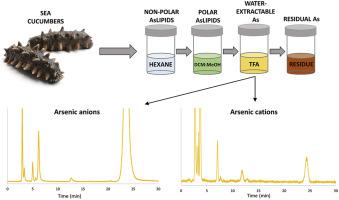Environmental Pollution ( IF 7.6 ) Pub Date : 2020-07-10 , DOI: 10.1016/j.envpol.2020.115190 Zuzana Gajdosechova 1 , Calvin H Palmer 1 , Deepika Dave 2 , Guangling Jiao 3 , Yanfang Zhao 4 , Zhijun Tan 4 , Jeffrey Chisholm 5 , Junzeng Zhang 6 , Roumiana Stefanova 6 , Abul Hossain 7 , Zoltan Mester 1

|
With the constant quest for new sources of superfoods to supplement the largely nutrient deficient diet of the modern society, sea cucumbers are gaining increasing popularity. Three species of sea cucumbers, Cucumaria frondosa, Apostichopus californicus and Apostichopus japonicas were collected from three geographical regions, Atlantic and Pacific coast of Canada and Yellow sea/East China sea in China, respectively. These organisms were sectioned into parts (body wall, tentacles, internal organ, skin and muscle) and analysed for total arsenic (As) by inductively coupled plasma mass spectrometry (ICP-MS) and As species by high-performance liquid chromatography (HPLC) coupled to ICP-MS. Normal and reversed sequential extractions were optimised to address As distribution between lipids (polar and non-polar) and water-extractable fractions. Two extraction methods for water-extractable As were compared in terms of the number and the amount of extracted species. The results revealed that total As concentration and As species distribution varies significantly between sea cucumbers species. Total As in studied body parts ranged between 2.8 ± 0.52 and 7.9 ± 1.2 mg kg−1, with an exception of the muscle tissue of A. californicus, where it reached to 36 ± 3.5 mg kg−1. Arsenobetaine (AsB) was the most abundant As species in A. californicus and A. japonicas, however, inorganic As represented over 70% of total recovered As in the body parts of C. frondosa. Arsenosugars-328 and 482 were found in all studied body parts whereas arsenosugar-408 was only found in the skin of A. californicus. This is the first time that such a variation in As species distribution between sea cucumber species has been shown.











































 京公网安备 11010802027423号
京公网安备 11010802027423号